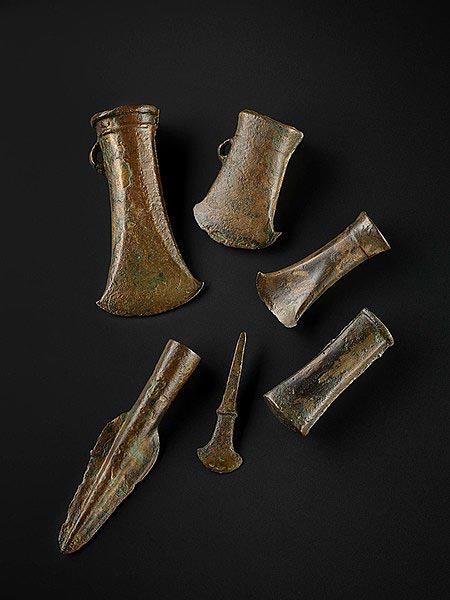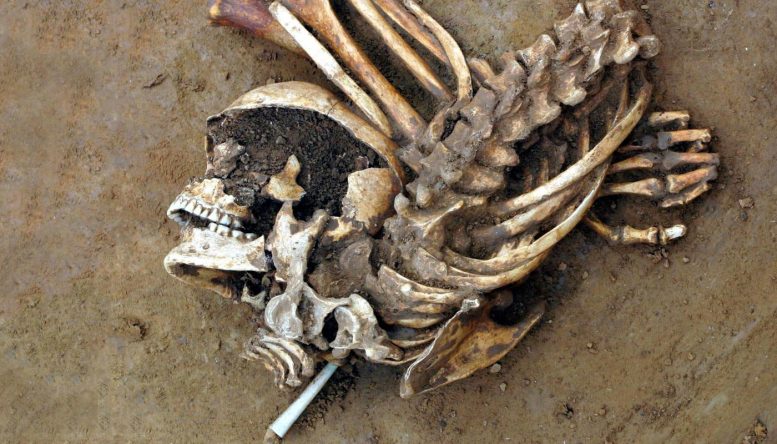Showing posts with label Bronze Age. Show all posts
Showing posts with label Bronze Age. Show all posts
Thursday, August 18
Prehistoric Grave Contains Gold Rings
ARCHAEOLOGISTS HAVE UNCOVERED A PREHISTORIC GRAVE CONTAINING 169 GOLD RINGS NEAR THE BIHARIA COMMUNE IN BIHOR COUNTY, CRIȘANA, ROMANIA.
The discovery was made during construction works for a new road that connects the city of Oradea with the A3 highway.
Excavations were conducted from march till the end of June by a multi-national team representing institutions from across Romania and Hungary, revealing three sites from the Neolithic Period, two from the middle to late Bronze Age, two from the Roman Period, and two sites from the Middle Ages.
In a press release announced by the Tarii Crisurilor Museum, archaeologists excavating near Biharia found the grave of a woman belonging to the Tiszapolgár culture.
The Tiszapolgár culture (4500–4000 BC), was an Eneolithic archaeological culture of the Great Hungarian Plain, the Banat, Crișana and Transylvania, Eastern Slovakia, and the Ukrainian Zakarpattia Oblast in Central Europe. READ MORE...
Wednesday, January 12
New Genetics Research
A photograph of the skeleton of one of the four individuals who we have sequenced who we think is likely to have participated in the migration we detect into southern Britain and to have displaced half the ancestry of the local population. This skeleton was excavated from the site of Cliffs End Farm in Kent. Credit: Wessex Archaeology
Two new studies highlight technological advances in large-scale genomics and open windows into the lives of ancient people.
New research reveals a major migration to the island of Great Britain 3,000 years ago and offers fresh insights into the languages spoken at the time, the ancestry of present-day England and Wales, and even ancient habits of dairy consumption.
The findings are described in Nature by a team of more than 200 international researchers led by Harvard geneticists David Reich and Nick Patterson. Michael Isakov, a Harvard undergraduate who discovered the existence of the migration, is one of the co-first authors.

This image is of bronze age tools from the National Museums of Scotland, which could give readers a sense of the material culture associated with people who lived at the time of the migration. Credit: Bronze Age tools curated the National Museums of Scotland
The analysis is one of two Reich-led studies of DNA data from ancient Britain that Nature published on Tuesday. Both highlight technological advances in large-scale genomics and open new windows into the lives of ancient people.
“This shows the power of large-scale genetic data in concert with archaeological and other data to get rich information about our past from a time before writing,” said Reich, a professor in the Department of Human Evolutionary Biology and a professor of genetics at Harvard Medical School. “The studies are not only important for Great Britain, where we now have far more ancient DNA data than in any other region, but also because of what they show about the promise of similar studies elsewhere in the world.”
The researchers analyzed the DNA of 793 newly reported individuals in the largest genome-wide study involving ancient humans. Their findings reveal a large-scale migration likely from somewhere in France to the southern part of Great Britain, or modern-day England and Wales, that eventually replaced about 50 percent of the ancestry of the island during the Late Bronze Age (1200 to 800 B.C.).
The study supports a recent theory that early Celtic languages came to Great Britain from France during the Late Bronze Age. It challenges two prominent theories: that the languages arrived hundreds of years later, in the Iron Age, or 1,500 years earlier at the dawn of the Bronze Age. READ MORE...
Two new studies highlight technological advances in large-scale genomics and open windows into the lives of ancient people.
New research reveals a major migration to the island of Great Britain 3,000 years ago and offers fresh insights into the languages spoken at the time, the ancestry of present-day England and Wales, and even ancient habits of dairy consumption.
The findings are described in Nature by a team of more than 200 international researchers led by Harvard geneticists David Reich and Nick Patterson. Michael Isakov, a Harvard undergraduate who discovered the existence of the migration, is one of the co-first authors.

This image is of bronze age tools from the National Museums of Scotland, which could give readers a sense of the material culture associated with people who lived at the time of the migration. Credit: Bronze Age tools curated the National Museums of Scotland
The analysis is one of two Reich-led studies of DNA data from ancient Britain that Nature published on Tuesday. Both highlight technological advances in large-scale genomics and open new windows into the lives of ancient people.
“This shows the power of large-scale genetic data in concert with archaeological and other data to get rich information about our past from a time before writing,” said Reich, a professor in the Department of Human Evolutionary Biology and a professor of genetics at Harvard Medical School. “The studies are not only important for Great Britain, where we now have far more ancient DNA data than in any other region, but also because of what they show about the promise of similar studies elsewhere in the world.”
The researchers analyzed the DNA of 793 newly reported individuals in the largest genome-wide study involving ancient humans. Their findings reveal a large-scale migration likely from somewhere in France to the southern part of Great Britain, or modern-day England and Wales, that eventually replaced about 50 percent of the ancestry of the island during the Late Bronze Age (1200 to 800 B.C.).
The study supports a recent theory that early Celtic languages came to Great Britain from France during the Late Bronze Age. It challenges two prominent theories: that the languages arrived hundreds of years later, in the Iron Age, or 1,500 years earlier at the dawn of the Bronze Age. READ MORE...
Friday, January 7
Ancient DNA Analysis

A photograph of the skeleton of one of the four individuals who we have sequenced who we think is likely to have participated in the migration we detect into southern Britain and to have displaced half the ancestry of the local population. This skeleton was excavated from the site of Cliffs End Farm in Kent. Credit: Wessex Archaeology
A major new study of ancient DNA has traced the movement of people into southern Britain during the Bronze Age.
A major new study of ancient DNA has traced the movement of people into southern Britain during the Bronze Age.
In the largest such analysis published to date, scientists examined the DNA of nearly 800 ancient individuals
The new study, led by the University of York, Harvard Medical School, and the University of Vienna, shows that people moving into southern Britain around 1300‒800 BC were responsible for around half the genetic ancestry of subsequent populations.

A major new study of ancient DNA has traced the movement of people into southern Britain during the Bronze Age.
A major new study of ancient DNA has traced the movement of people into southern Britain during the Bronze Age.
In the largest such analysis published to date, scientists examined the DNA of nearly 800 ancient individuals
The new study, led by the University of York, Harvard Medical School, and the University of Vienna, shows that people moving into southern Britain around 1300‒800 BC were responsible for around half the genetic ancestry of subsequent populations.

This image is of bronze age tools from the National Museums of Scotland, which could give readers a sense of the material culture associated with people who lived at the time of the migration. Credit: Bronze Age tools curated the National Museums of Scotland
The combined DNA and archaeological evidence suggests that, rather than a violent invasion or a single migratory event, the genetic structure of the population changed through sustained contacts between mainland Britain and Europe over several centuries, such as the movement of traders, intermarriage, and small scale movements of family groups.
The study finds evidence that the new migrants became thoroughly mixed in to the Southern British population in the period 1000‒875 BC.
The researchers say the origin of these migrants cannot yet be established with certainty, but they are most likely to have come from communities in and around present-day France.
The Middle to Late Bronze Age was a time when settled farming communities expanded across the landscapes of southern Britain, and extensive trade routes developed to allow the movement of metal ores for the production of bronze.
These new networks linked wide-ranging regions across Europe, as seen from the spread of bronze objects and raw materials.
The study’s lead archaeologist Professor Ian Armit, from the University of York, said: ‘We have long suspected, based on patterns of trade and shared ideologies, that the Middle to Late Bronze Age was a time of intense contacts between communities in Britain and Europe. READ MORE...
The combined DNA and archaeological evidence suggests that, rather than a violent invasion or a single migratory event, the genetic structure of the population changed through sustained contacts between mainland Britain and Europe over several centuries, such as the movement of traders, intermarriage, and small scale movements of family groups.
The study finds evidence that the new migrants became thoroughly mixed in to the Southern British population in the period 1000‒875 BC.
The researchers say the origin of these migrants cannot yet be established with certainty, but they are most likely to have come from communities in and around present-day France.
The Middle to Late Bronze Age was a time when settled farming communities expanded across the landscapes of southern Britain, and extensive trade routes developed to allow the movement of metal ores for the production of bronze.
These new networks linked wide-ranging regions across Europe, as seen from the spread of bronze objects and raw materials.
The study’s lead archaeologist Professor Ian Armit, from the University of York, said: ‘We have long suspected, based on patterns of trade and shared ideologies, that the Middle to Late Bronze Age was a time of intense contacts between communities in Britain and Europe. READ MORE...
Subscribe to:
Comments (Atom)

